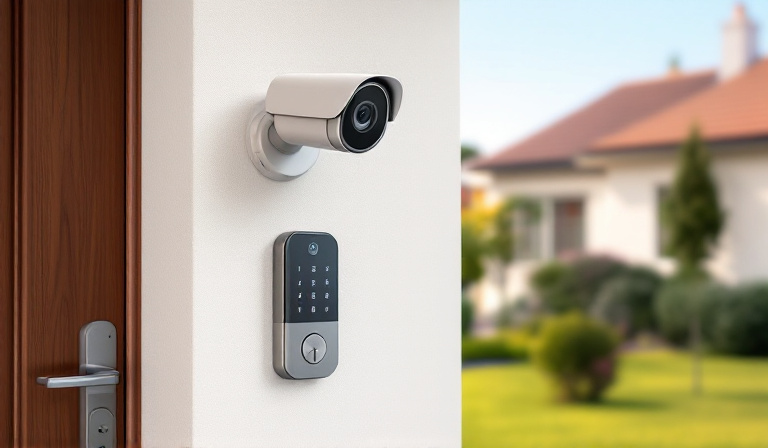
In today's world, ensuring the safety and security of our homes and workplaces has become more crucial than ever. With advancements in technology, security devices have evolved significantly, providing us with more sophisticated and reliable tools to protect our spaces. In this blog post, we'll delve into the realm of security devices, exploring cameras, sensors, and more, offering practical advice on how to enhance your security setup.
Understanding Security Cameras
Security cameras have become a staple in modern security systems. They serve as the eyes of your security setup, offering visual surveillance and peace of mind. Here's what you need to know about them:
Types of Security Cameras
- Wired Cameras: These cameras are connected to a recording device via cables. They are known for their reliability and consistent video quality, making them ideal for permanent installations.
- Wireless Cameras: Offering more flexibility, wireless cameras transmit video through Wi-Fi. They are easier to install and can be relocated as needed, perfect for renters or those looking for a temporary setup.
- IP Cameras: Internet Protocol cameras send and receive data via a network, allowing for remote viewing from anywhere with an internet connection. They often come with advanced features like motion detection and night vision.
- PTZ Cameras: Pan-Tilt-Zoom cameras offer the ability to move the camera lens and zoom in on specific areas, providing comprehensive coverage with just one camera.
Placement Tips for Cameras
The effectiveness of security cameras largely depends on their placement. Here are some tips for optimal positioning:
- Place cameras at entry points such as front doors, back doors, and windows to capture anyone entering or exiting.
- Ensure cameras are installed at a height that prevents tampering, yet provides a clear view of the area.
- Consider installing cameras with wide-angle lenses for broader coverage.
- Use cameras with night vision capabilities for round-the-clock surveillance.
- Avoid pointing cameras directly into the sun, as it can cause glare and reduce image quality.
The Role of Sensors in Security Systems
Sensors are the unsung heroes of security systems, detecting changes in the environment and triggering alerts. Here's a breakdown of common sensor types:
Types of Security Sensors
- Motion Sensors: These sensors detect movement within a designated area. They are ideal for monitoring large spaces and can activate alarms or cameras when triggered.
- Door/Window Sensors: These sensors use magnetic fields to detect when a door or window is opened. They are crucial for perimeter security, alerting you to unauthorized entry.
- Glass Break Sensors: Designed to detect the sound of breaking glass, these sensors are perfect for reinforcing window security.
- Smoke and Carbon Monoxide Detectors: While primarily focused on safety, these sensors can be integrated into security systems to provide comprehensive protection.
Installing and Maintaining Sensors
Proper installation and maintenance of sensors are key to a reliable security system. Consider the following tips:
- Position motion sensors in strategic locations, such as hallways and staircases, to maximize coverage.
- Regularly test your sensors to ensure they are functioning correctly.
- Replace batteries in wireless sensors as needed to maintain performance.
- Consider professional installation for complex systems to ensure optimal setup.
Enhancing Your Security Setup
Beyond cameras and sensors, there are additional devices and strategies to bolster your security system:
Smart Locks
Smart locks offer keyless entry and can be controlled remotely via smartphones. They provide convenience and enhanced security, allowing you to monitor and manage access to your property.
Alarm Systems
An alarm system is a vital component of any security setup. It can deter intruders and alert you or authorities in case of a breach. Modern systems often integrate with cameras and sensors for a comprehensive solution.
Lighting
Strategic lighting can deter potential intruders by eliminating hiding spots. Consider motion-activated lights for pathways and entrances to enhance visibility and security.
Professional Monitoring
For an added layer of security, consider professional monitoring services. These services provide 24/7 surveillance and can dispatch emergency services when necessary.
Security System Maintenance
Regular maintenance of your security system is essential to ensure its effectiveness. Schedule periodic checks, update software, and replace any faulty equipment to keep your system in top shape.
Conclusion
Investing in a robust security system is a wise decision to protect your home or business. By understanding the various security devices available and implementing them strategically, you can create a safe and secure environment. Remember, the best security system is one that is well-maintained and tailored to your specific needs. Whether you're starting from scratch or enhancing an existing setup, the combination of cameras, sensors, and other devices will provide peace of mind and protection for you and your loved ones.

